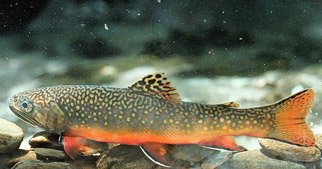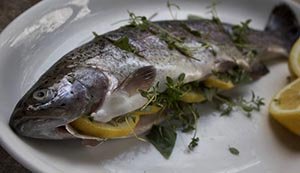Brook trout Nutrition facts
Brook trout is one of the delicious, freshwater fish native to the Eastern regions of North America. No wonder this beautiful fish has been named as the 'state fish' of nine Eastern states of the U.S., including New York.
In the Taxonomy, brook trout belongs to the Salmonidae family and genus: Salvelinus, and is closely related to char.
Scientific name: Salvelinus fontinalis.
It is also known by many local names as eastern brook trout, speckled trout, brook char, squaretail, or mud trout.
 |
| Brook trout. Courtesy: NPS Photo |
They generally live in the cold waters of creeks, streams, rivers, and lakes, although some of them migrate to live in the sea ("salters"); in which case, they return to freshwater for spawning like salmon.
Brook trout flesh is semi-fatty, very fine, and aromatic. Their meat also varies in color, being white, ivory, pink, and reddish depending upon varying feeding characteristics.
Description:
Brook trout are cool, freshwater, small to medium size, semi-fatty flesh.
Brook trout exhibits a long, streamlined, oval body, small head, and a lower opening mouth that opens back below its eye. The color variations include olive, blue-gray, or brown above with a silvery-white belly.
The body features pale yellow worm-like markings along the dorsal surface and dorsal fin and iridescent spots that are lighter than the body color. On their sides, they have small red spots often surrounded by bluish halos among larger yellow spots.
Brook has a light (white) edging on its fins, which distinguishes it from brown trout. The tail fin is square. During spawning time in the fall, male brook trout can turn their color bright orange-red along the sides.
Adult freshwater brook trout measures 10-25 inches and weighs up to 5-20 pounds.
Life cycle:
Brook trout normally mature in two years. They spawn between September and October. Females lay eggs in a gravel nest called "redd". Irrespective of whether fresh or saline-water habitat, trouts return to their natal waters for reproduction.
Tiny alevins and small fry thrive well in cold, clean, oxygenated water to survive and feed primarily on plankton, insect larvae, and other fish larvae.
Brook trout lifespan varies widely from 7 years.
Habitat:
Brook trout prefers clean, oxygenated, cold streams of the northern water bodies, but sometimes in brackish water bodies and estuaries also.
Small brook subtypes spend their entire life in freshwater cold streams, rivulets, and small rivers. Anadromous trout (salters) species are migratory, completing their journey from natal freshwater streams, rivers, lakes, cold creeks, estuaries open bays, and deep ocean waters and back again to their natal waters to spawn.
Adult brook feeds on insects, mollusks, and small fish.
Health Benefits of Brook trout
Brook trout is low in calories; 3.5 oz fish hold just 110 calories in contrast to 119 and 179 rainbow trout and salmons respectively.
Brook trout carry a good amount of protein. Their lean meat is composed of 21.2 g/3.5 oz (38% of RDI) of protein, being complete in all essential amino acids in healthy proportions.
Studies suggest that consumption of seafood decreases the risk of heart attack, stroke, obesity, and hypertension. Seafood is low in saturated fat and higher in “heart healthful” polyunsaturated fat, including omega-3 fatty acids.
American Heart Association recommends consumption of at least 2 servings of oily fish to fulfill requirements of essential fatty acids, protein, minerals, and fat-soluble vitamins.
All species of trouts are rich sources of vitamin A, vitamin D, and long-chain omega-3 fatty acids (PUFA).
As in other oily-fish types, brook trout also is a rich source of omega-3 eicosapentaenoicacid (EPA), docosapantaenoicacid (DPA) and docosahexaenoic acid (DHA) fatty acids. Research studies suggest that these fatty acids, particularly DHA, play an important role in the development of neural systems, especially in infants and children.
According to Cornell University and the New York Sea Grant Extension Program. 2012- These fatty acids can help lower blood pressure and heart rate and improve cardiovascular function. For example, research has shown that omega-3 fatty acids decrease the risk of arrhythmias (abnormal heartbeats) that can lead to sudden death. Omega-3 fatty acids also decrease triglyceride levels and slow the growth rate of atherosclerotic plaque.
In adults, several large trials have evaluated the effect of fish or fish oils on heart disease. In the "GISSI Prevention Trial, heart attack survivors who took a 1-gram capsule of omega-3 fats every day for three years were less likely to have a repeat heart attack, stroke, or die of sudden death than those who took a placebo".
The essential vitamins in brook trout contain include niacin, vitamin B6, vitamin E, vitamin B12, thiamin, and riboflavin. In addition, being an oily fish, trout have generous amounts of vitamins A and D.
It has small amounts of Vitamin-A (57 IU/100g) on comparison to salmon's. vitamin-A and omega-3 are essential for healthy mucosa and skin.
Its flesh carries less vitamin D (155 IU/100g) than salmon's (526 IU/100 g). Vitamin D plays an important role in the calcium metabolism and offers protection from cancers.
The Food and Drug Administration (FDA) recommends that pregnant women eat at least 8 ounces and up to 12 ounces (340 grams) of a variety of seafood lower in mercury a week.
Trouts are naturally rich sources of minerals including calcium, zinc, potassium, phosphorus, and magnesium. It is also a rich dietary source of iodine.
| Principle | Nutrient Value | Percent of RDA |
|---|---|---|
| Energy | 110 Kcal | 5.5% |
| Carbohydrates | 0 g | 0% |
| Protein | 21.2 g | 38% |
| Total Fat | 2.73 g | 13.65% |
| Cholesterol | 60 mg | 20% |
| Dietary Fiber | 0 g | 0% |
| Vitamins | ||
| Niacin | 5.29 mg | 33% |
| Pyridoxine | 0.273 mg | 21% |
| Riboflavin | 0.101 mg | 7.75% |
| Thiamin | 0.137 mg | 11% |
| Vitamin B12 | 2.77 μg | 115% |
| Vitamin-A | 57 IU | 2% |
| Vitamin-C | 0 mg | 0% |
| Vitamin-D | 155 IU | 39% |
| Vitamin-E | 0.20 mg | 1% | Electrolytes |
| Sodium | 45 mg | 3% |
| Potassium | 417 mg | 9% |
| Minerals | ||
| Calcium | 25 mg | 2.5% |
| Iron | 0.38 mg | 5% |
| Magnesium | 28 mg | 7% |
| Phosphorus | 246 mg | 35% |
| Zinc | 0.55 mg | 5% |
| Omega-3 fats (PUFA) | ||
| EPA (20:5 n-3) | 0.069 g | -- |
| DPA (22:5 n-3) | 0.033 g | -- |
| DHA (22:6 n-3) | 0.252 g | -- |
Buying
You can buy brook trout fresh or frozen, whole, trimmed, fileted, and sometimes steaks. It is also available smoked, salt-cured, or in cans.
Buy good quality fish from authentic sellers. Buy a whole brook trout side or a fillet that is from the thickest cut of the fish. Wild-caught trout will have pinker and brighter flesh than farmed ones. Wild trout are nutritionally rich and contain fewer toxins than farmed ones.
There are some reported cases of artificial colorants/dye in farmed trouts to portray them as pink, wild trout.
In the markets, you can find products like ready-to-cook pâté, kabobs, and marinated and peppered trout steaks and fillets, salted trout, and burgers.
Brook trout never smell fishy, or amine odor, if so, avoid them. Also, avoid smoked trout with leaky and wet edges.
It spoils quickly as its flesh is fatty and attracts bacteria. Always store fillets/sections of fish in a deep freezer.
Preparation
Prepare trout as simply as possible so as not to mask its delicate flavor. Smoked brook trout is equally delicious.
The scales on the skin can be left on. The fillets are very easy to remove. The flesh close to the head of the trout is more delicate than the flesh nearer the tail. If you prefer to skin, just peel it inside out. Remove any bones before cooking.
Brook trout can be substituted in all recipes that call for char, salmon, and other trout members. It may be pan-roasted, shallow fried, broiled, foil-baked, and grilled in the preparation of a variety of mouth-watering menus.
Do not overcook. It is fine cooked until the meat is opaque and flakes off easily.
Here are some serving ideas:
 |
| Baked trout. Photo credit: Jan Murin |
Brook trout is employed in the preparation of sandwiches, salads, omelets, pasta dishes, mousses, and quiches.
Smoked brook is served with capers and cream cheese as appetizer.
Marinade whole brook trout with lemon slices and herbs (minced garlic, thyme, parsley, peppercorns, etc) for an hour. Then bake or grill and serve with lemon wedges.
Canned brook trout is employed in mousse, soufflés, pâté and crepes. As a spread, it is used on sandwiches, and canapés.
In Japan ikura is a red caviar made from the roe of salmon, trout, or cod. It is employed in sushi, and rice dishes in Japan.
Safety profile
Brook trout, being seafood, may harbor microorganisms, such as parasites, bacteria, and viruses, that may cause foodborne illness. It is important to handle seafood safely to prevent foodborne illness. (Medical disclaimer).
Also read ≻≻-
≻≻- Channel Catfish nutrition facts.
≻≻- Trout nutrition facts.
≻≻- Sockeye salmon nutrition facts and health benefits.
≻≻-Back to Seafood from Brook trout nutrition facts and health benefits.
≻≻-Back to Home page.
Further reading (Links opens in new window):
U.S Fish And Wildlife Service- Salvelinus fontinalis. PDF.
Omega-3 Fatty Acids: An Essential Contribution.